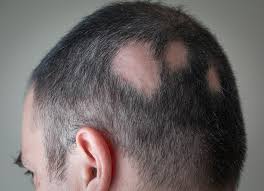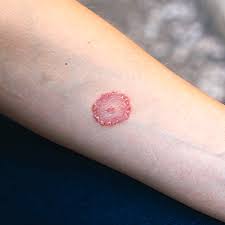
 Dermatophytosis (Ringworm)
Dermatophytosis (Ringworm)
Dermatophytosis, also known as ringworm, is a fungal infection of the skin.
Clinically results in a red, itchy, scaly, circular rash.
Hair loss may occur in the area affected.
Symptoms begin four to fourteen days after exposure.
Multiple areas can be affected.
About 40 types of fungus can cause ringworm:
Trichophyton, Microsporum, or Epidermophyton type.
Risk factors include: the use of public showers, contact sports such as wrestling, excessive sweating, contact with animals, obesity, and poor immune function.
It can spread from other animals or between people.
Diagnosis of Dermatophytosis is often based on the appearance and symptoms.
It may be confirmed by either culturing or observing a skin scraping under a microscope.
Prevention of dermatophytosis: keeping the skin dry, not walking barefoot in public, and not sharing personal items.
Treatment is typically with antifungal creams such as clotrimazole or miconazole, but if the the scalp is involved, antifungals by mouth such as fluconazole may be needed.
Globally, up to 20% of the population may be infected by ringworm at any given time.
Ringworm infections of the groin are more common in males.
Infections of the scalp and body occur equally in both sexes.
Ringworm infections of the scalp are most common in children while infections of the groin are most common in the elderly.
Infections on the body may give rise to typical enlarging raised red rings of ringworm.
Infection on the skin of the feet may cause athlete’s foot and in the groin, jock itch, and involvement of the nails is termed onychomycosis.
Animals including dogs and cats can also be affected by ringworm, and the disease can be transmitted between animals and humans, making it a zoonotic disease.
Signs of the disease can be:
red, scaly, itchy or raised patches.
Patches may be redder on outside edges or resemble a ring
patches that begin to ooze or develop a blister.
Bald patches may develop when the scalp is affected
Fungi thrive in moist, warm areas, locker rooms, tanning beds, swimming pools, and skin folds.
Dermatophytosis may be spread by using exercise machines that have not been disinfected after use, or by sharing towels, clothing, footwear, or hairbrushes.
Dermatophyte infections can be readily diagnosed based on the history, physical examination, and potassium hydroxide (KOH) microscopy.
Three types of tinea (capitis, corporis, and barbae)
A number of different species of fungus are involved in dermatophytosis.
Dermatophytes of the genera Trichophyton and Microsporum are the most common causative agents.
Dermatophytosis:
Tinea pedis (athlete’s foot): fungal infection of the feet
Tinea unguium: fungal infection of the fingernails and toenails, and the nail bed
Tinea corporis: fungal infection of the arms, legs, and trunk
Tinea cruris (jock itch): fungal infection of the groin area
Tinea manuum: fungal infection of the hands and palm area
Tinea capitis: fungal infection of the scalp and hair
Tinea faciei (face fungus): fungal infection of the face
Tinea barbae: fungal infestation of facial hair
Other superficial mycoses which are not classic ringworm, since not caused by dermatophyte:
Tinea versicolor: caused by Malassezia furfur
Tinea nigra: caused by Hortaea werneckii
Prevention
Avoid sharing clothing, sports equipment, towels, or sheets.
Wash clothes in hot water with fungicidal soap after suspected exposure to ringworm.
Avoid walking barefoot; wearing appropriate protective shoes in locker rooms and sandals at the beach.
Avoid touching pets with bald spots, as they are often carriers of the fungus.
For horses, dogs and cats there is available an approved inactivated vaccine
Treatment:
Antifungal treatments include topical agents such as miconazole, terbinafine, clotrimazole, ketoconazole, or tolnaftate applied twice daily until symptoms resolve — usually within one or two weeks.
Topical treatments should then be continued for a further 7 days after resolution of visible symptoms to prevent recurrence.
In more severe cases or scalp ringworm, systemic treatment with oral medications (such as itraconazole, terbinafine, and ketoconazole) may be utilized.
To prevent spreading the infection, the lesions should not be touched.
Good hygiene maintained with washing of hands and the body.
Erroneous treatment of ringworm with a topical steroid, a standard treatment of the superficially similar pityriasis rosea, can result in tinea incognito, a condition where ringworm fungus grows without typical features, such as a distinctive raised border.
The most common term ringworm, is a misnomer, since the condition is caused by fungi of several different species and not by parasitic worms.
Worldwide, superficial fungal infections caused by dermatophytes are estimated to infect around 20-25% of the population and it is thought that dermatophytes infect 10-15% of the population during their lifetime.
The highest incidence of superficial mycoses result from dermatophytoses which are most prevalent in tropical regions.
Tinea pedis + onychomycosis, Tinea corporis, Tinea capitis are the most common dermatophytosis found in humans across the world.
Tinea capitis has a greater prevalence in children.
The increasing prevalence of dermatophytes resulting in Tinea capitis has been causing epidemics throughout Europe and America.
In pets, cats are the most affected by dermatophytosis.
Pets are susceptible to dermatophytoses caused by Microsporum canis, Microsporum gypseum, and Trichophyton.
For dermatophytosis in animals, risk factors depend on age, species, breed, underlying conditions, stress, grooming, and injuries.
Chronicity is a common for dermatophytosis in India: prevalence of dermatophytosis in India is between 36.6 and 78.4% depending on the area, clinical subtype, and dermatophyte isolate.
Individuals ages 21–40 years are most commonly affected.
A
